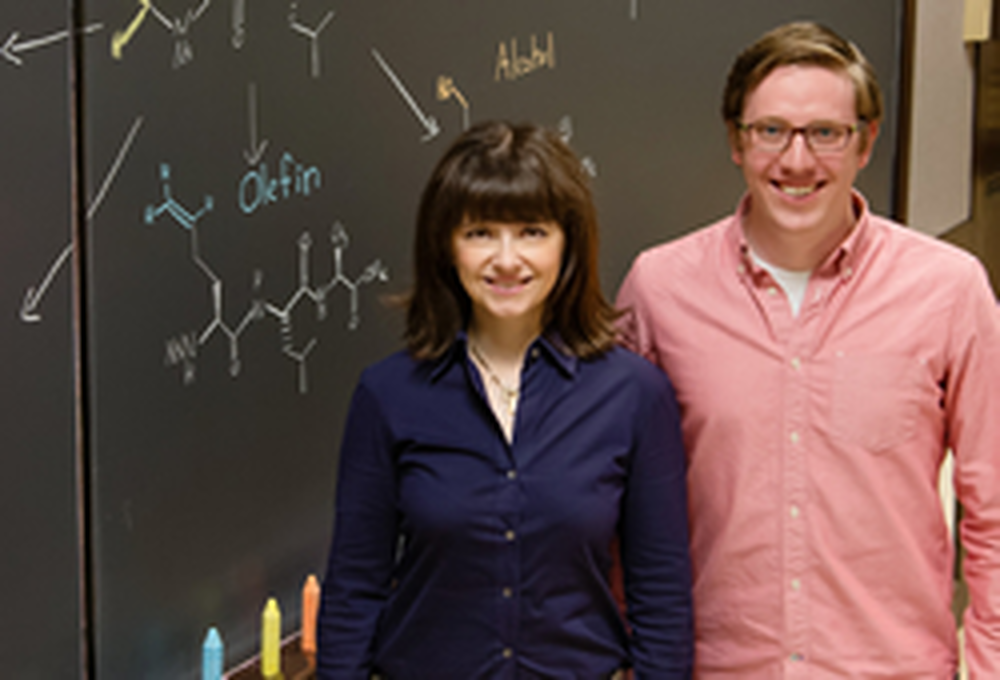
Chemists led by University of Illinois professor M. Christina White and graduate student Thomas Osberger found that two small-molecule iron catalysts can oxidize chiral amino acids and peptides to an array of unnatural forms, giving researchers more options for developing drug candidates.
For medicinal chemists, making tweaks to peptide structures is key to developing new drug candidates. Now, researchers have demonstrated that two iron-containing small-molecule catalysts can help turn certain types of amino acids – the building blocks of peptides and proteins – into an array of potential new forms, even when part of a larger peptide, while preserving a crucial aspect of their chemistry: chirality, or “handedness.”
Led by Illinois chemistry professor M. Christina White, researchers from the University of Illinois at Urbana-Champaign in collaboration with researchers at Pfizer Global Research and Development detailed the new reactivity of the catalysts in the journal Nature.
“This allows us to take one amino acid structure and convert it into many different structures that represent different functionalities, which could ultimately lead to different biological and physical properties of the peptide,” White said. “It also expands the pool of unnatural chiral amino acids that are available to researchers to make new structures.”
A main advantage to the catalysts, which oxidize bonds between carbon and hydrogen, is that they preserve the amino acid’s sense of chirality. Chiral molecules can have more than one spatial arrangement of their atoms, or stereochemistry, sometimes known as “right-hand” and “left-hand” versions. Although they share the same chemical formula, molecules of opposite handedness can behave very differently in the body. For example, L-DOPA is a drug used to treat Parkinson’s disease, whereas its mirror version, D-DOPA, is biologically inactive.
“That’s why having things with defined stereochemistry can be very important for drug discovery,” White said. “It can be that a molecule of one handedness has fantastic physiological properties, but the same molecule with the opposite handedness could have very detrimental properties.”
Using the two iron catalysts, the researchers were able to take four chiral amino acids – proline, leucine, valine and norvaline – and diversify them into 21 different amino acid structures while preserving their handedness. The new structures can be used to create modified versions of existing peptides or to build entirely new structures.
Such oxidative amino acid modification is performed routinely in nature to make a variety of different peptides with different properties. Twenty common amino acids exist in nature, but are altered by carbon-hydrogen oxidation reactions to change their shape or add functional groups such as alcohols or carboxylic acids. These reactions are typically catalyzed by iron-containing enzymes. However, the enzymes are very difficult to work with in a laboratory setting, White said.
“These enzymes are also very specific. They are usually tailored to one amino acid or one peptide structure,” White said. “Two big advantages to the small-molecule catalysts we’ve developed are that they are very general – they can work on many different amino acid and peptide structures – and they are very easy to use. They can create great diversity initiated by one simple carbon-hydrogen oxidation reaction.”
Another major advantage the catalysts have is that, while they are general in what substrate they can oxidize, they are very specific about which carbon-hydrogen bonds they cut – so much so that they target a certain spot on amino acids like proline, leucine or valine even when they are part of a much larger peptide chain. For example, the researchers used the catalysts to transform a single proline-containing peptide chain into eight different peptides containing unnatural amino acids.
“This is powerful because right now, if you want to make those eight different peptides, you would have to do eight different syntheses,” White said. “And before you could do that, you’d have to synthesize the individual unnatural amino acid components. With our method, you can build one peptide out of bulk chemicals and use one carbon-hydrogen oxidation reaction, coupled with a reaction to add a functional group, to produce eight new peptides all with retained handedness.”
One of the small-molecule iron catalysts, iron PDP, is available commercially from Sigma-Aldrich and Strem, and the researchers are in talks to make the second catalyst available as well.
White’s group is working on catalysts that can modify a wider range of amino acids, particularly those with electron-rich aromatic functionality, which compete with the carbon-hydrogen bonds for oxidation using the current catalyst.
The National Institute of General Medical Sciences at the National Institutes of Health and Pfizer supported this work.
Article excerpted from a University of Illinois article by Liz Ahlberg Touchstone
Photo courtesy of M. Christina White